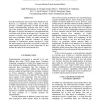Free Online Productivity Tools
i2Speak
i2Symbol
i2OCR
iTex2Img
iWeb2Print
iWeb2Shot
i2Type
iPdf2Split
iPdf2Merge
i2Bopomofo
i2Arabic
i2Style
i2Image
i2PDF
iLatex2Rtf
Sci2ools
76
Voted
MJ
2008
2008
Cell architecture for nanoelectronic design
Several nanoelectronic devices have been already proved. However, no architecture which makes use of them provides a feasible opportunity to build medium/large systems. Nanoarchitecture proposals only solve a small part of the problems needed to achieve a real design. In this paper, we propose and analyze a cell architecture that overcomes most of those at the gate level. Using the cell structure we build 2 and 3-input NAND gates showing their error probabilities. Finally, we outline a method to further improve the structure's tolerance by taking advantage of interferences among nanodevices. Using this improvement we show that it is possible to reduce the output standard deviation by a factor larger than N and restitute the signal levels using nanodevices.
Related Content
| Added | 13 Dec 2010 |
| Updated | 13 Dec 2010 |
| Type | Journal |
| Year | 2008 |
| Where | MJ |
| Authors | Ferran Martorell, Antonio Rubio |
Comments (0)

